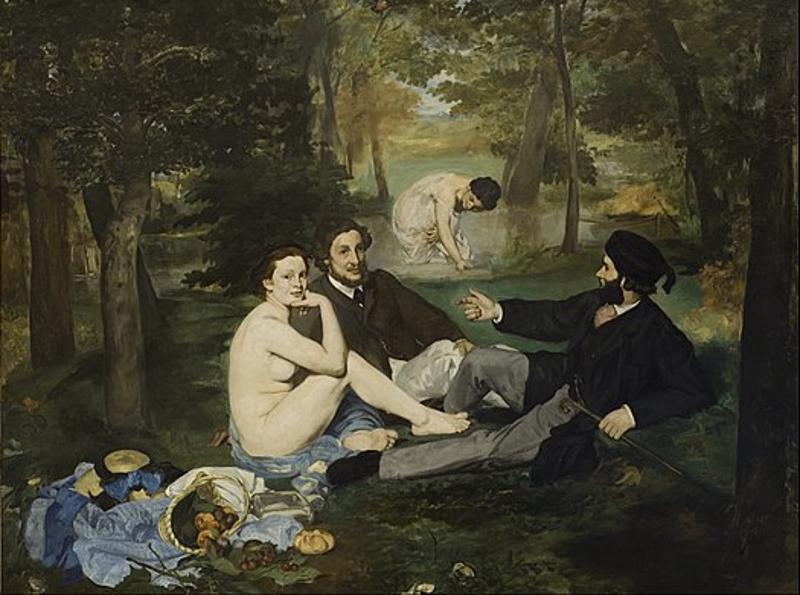My diary
Since the 18th century the Salon was the make-or-break venue for artists. An extension of Paris's Academy of Fine Arts, the salon's yearly exhibitions showcased work that represented the "best" work in France. However, in the mid-19th century, the Salon was faced with the rising popularity of a new kind of art among forward-thinking painters--impressionism. But the Salon was not about to change its tastes, resulting in a year that saw an unprecedented number of rejections of submitted work. In typical French fashion, some of the painters rebelled, rejecting, in a sense, the authority of the government-funded salon and forming their own. At this "Salon of the Rejected" the impressionists found solidarity and their movement was born. The Salon des Refuses also featured one of my favourite paintings--Le Dejeuner sur l'Herbe.
To be perfectly clear: this painting is NOT my favourite painting because I think it's extremely pretty, or even because of some the risks Manet took with his artistic technique. I like this painting because it causes myself and others to be uncomfortable in a way that few of the other hundreds of paintings in Musee D'Orsay can. Walking through the museum, one sees painting after painting portraying the nude female form, but it always seems to fit in the painting--the woman is an object that is beautiful, just like the scenery around her. The discomfort of inappropriate vulnerability that comes with seeing an individual person displayed in the nude is lost in the painter's portrayal. To me, the woman gazing at the viewer in Monet's famous work breaks that third wall that separates art from reality. It is jarring. Why is the woman not clothed like her male companions? Why is the lighting so harsh? Why is the woman bathing in the back so unrealistically large? The magic of a perfectly crafted second world is broken. The painting is obviously unrealistic--but in being so, it may cause the viewer to ask questions about the reality behind the painting. To what extent is the
cometdogiscute
14 chapters
16 Apr 2020
The Look of Confrontation
Since the 18th century the Salon was the make-or-break venue for artists. An extension of Paris's Academy of Fine Arts, the salon's yearly exhibitions showcased work that represented the "best" work in France. However, in the mid-19th century, the Salon was faced with the rising popularity of a new kind of art among forward-thinking painters--impressionism. But the Salon was not about to change its tastes, resulting in a year that saw an unprecedented number of rejections of submitted work. In typical French fashion, some of the painters rebelled, rejecting, in a sense, the authority of the government-funded salon and forming their own. At this "Salon of the Rejected" the impressionists found solidarity and their movement was born. The Salon des Refuses also featured one of my favourite paintings--Le Dejeuner sur l'Herbe.
To be perfectly clear: this painting is NOT my favourite painting because I think it's extremely pretty, or even because of some the risks Manet took with his artistic technique. I like this painting because it causes myself and others to be uncomfortable in a way that few of the other hundreds of paintings in Musee D'Orsay can. Walking through the museum, one sees painting after painting portraying the nude female form, but it always seems to fit in the painting--the woman is an object that is beautiful, just like the scenery around her. The discomfort of inappropriate vulnerability that comes with seeing an individual person displayed in the nude is lost in the painter's portrayal. To me, the woman gazing at the viewer in Monet's famous work breaks that third wall that separates art from reality. It is jarring. Why is the woman not clothed like her male companions? Why is the lighting so harsh? Why is the woman bathing in the back so unrealistically large? The magic of a perfectly crafted second world is broken. The painting is obviously unrealistic--but in being so, it may cause the viewer to ask questions about the reality behind the painting. To what extent is the

portrayal of the female form in art praise of beauty, and to what extent does it remove the personhood of women and portray them as nothing more than another beautiful picture? While it may not have been infamous-lady's-man Manet's intention, his work to me helps break through centuries of assumption to make a viewer ask questions about the people behind each painting.
1.
Bonjour! No wait--Bonsoir! Nope, too formal. Uh...Salut!
2.
A "Why" Beyond Our Sight
3.
Cathredrals
4.
Opulence and Oppression
5.
The Church That Felt Like Home
6.
Ready, Set....Slow Down.
7.
The Weight of 9,000 Marble Crosses
8.
A Roman Holiday
9.
Home Sweet Home
10.
Tout Les Chocolats!
11.
The Look of Confrontation
12.
Liberty!
13.
Old Friend, New Country
14.
An October in Annecy